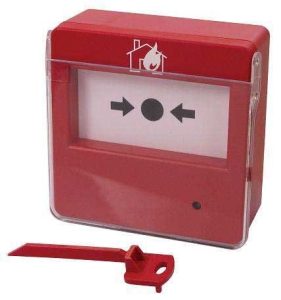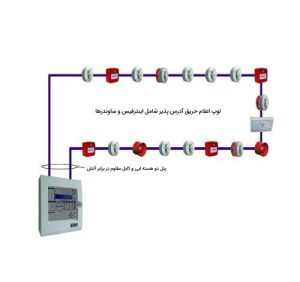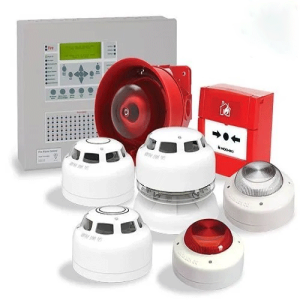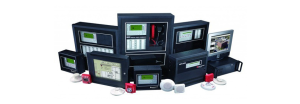What is a fire alarm system?

Fire alarm systems are a set of firefighting equipment that are responsible for reporting and revealing the location of a fire.
A fire alarm system is designed to alert people in an emergency so that action can be taken to protect themselves, employees, and the public. And they are found in offices, factories and public buildings. These systems have become part of our daily routine, in fact, they are often overlooked until something happens in that location or situation.
Whatever the fire alarm system is, if it is activated, the alarm bells built into them will inform the people in the building to transmit the fire message and evacuate it.
These systems may also have a remote signaling system that can alert the fire brigade through a central station.
In this article, we mention “types of fire alarm equipment” and in the following articles, we will examine each of them separately.

Types of available equipment:
detector
chassis
Siren
Central panel
Remote indicator
interface
repeater
Isolator
Loop card
Fire alarm cable
battery
Smoke test spray

Addressable fire alarm
Fire alarm devices and control panels known as “addressable fire alarms” are distinguished by their ability to identify each of the active fire alarm devices. This technical innovation meets the requirements for electrical monitoring of all fire alarm devices and provides a means of identifying the point in the building where the alarm was first activated.
The data communication path is the core of the system

However, addressable fire alarm systems depend on the data communication path. The central core connects the fire alarm devices. This technology enables the design of a system where all fire alarm devices, interfaces, sounders and signal controls can be connected on a single pair of conductors embedded throughout the building. This connection must be properly established between the system components. If this communication is not established when there is a fire, it will cause irreparable damage.
Not damaging the fire alarm system during a fire
One of the most important issues to consider in fire alarm systems is how to protect a fire alarm system during a fire. It is expected that warning systems should continue to provide a level of performance during a fire disaster. In a significant fire, components wear out quickly and a failure of fire alarm wiring can disable the fire alarm system within minutes unless adequately protected. In the large fires that have happened until today, the vulnerability of the fire alarm system is its deactivation after a few minutes of the fire. In previous fires, unfortunately, both conventional fire alarm systems and voice communication systems were destroyed in the first few minutes of the fire. The same destructive result can occur in an addressable fire alarm system. However, the addressable fire alarm system with a precise design can be the most durable against the heat caused by the fire.
Fault Isolation Modules provide the necessary protection
A fault isolation module is a circuit that controls data communication between installed isolators. In case of a short circuit error, it may disable the system. Decouplers identify the segment that caused the connection and remove it, allowing data on all remaining segments to pass through an alternate path until the fault is resolved. Where a DCL circuit connects addressable fire alarm devices at more than one point.
Fault isolation modules may not be required in all DCL circuits. In this case, there is an alternative tool to achieve better performance. If the addressable devices connecting the DCL can be confined to a fire zone and the fire alarm control unit is safely located in an electrical room separate from the fire location, a DCL failure will not affect the operation of any other fire alarm. . However, in most cases, fault isolation modules are part of the solution in DCL with addressable devices.
The alternative route also needs protection
Fault isolation modules alone do not provide a solution. The alternate path is critical to achieving performance, and the alternate path itself needs protection. However, the alternate path is the secure path through which data is routed to the rest of the addressable fire alarm systems. DCL must connect all addressable devices in a loop and return to the control unit in another way. This route cannot be unprotected by the same fire zone, as a fire in that zone can disable the primary route section as well as part of the alternate route.
Isolation modules must be used in transitions between zones
Each time the DCL leaves one fire zone and enters another, fault isolation modules used for data communication must be installed at the transfer point. The section between the separators defines the section that may be interrupted in the event of a fault. That section must not exceed a fire zone. This provision of fault isolation modules in transmission between zones is necessary to achieve the performance survival objective required to limit the effect of a fault to one fire zone.
Two isolators are necessary to meet the performance standard
One of the most important challenges is where to place the fault isolation modules. In order to achieve this goal, fault isolation modules are usually placed in areas that may not be accessible during a fire. Ideally, the fault isolation module should be in an electrical service room away from fire. Since each isolator has interconnecting wiring for two separate fire zones and protects two zones, exposing the isolator to fire can compromise the isolator wiring. It is therefore necessary to use two isolators to meet the standard performance level of the installation: one at the last wired point before exiting the fire zone and the other at the first wired point entering the next fire zone.
The exception to the need for pairs of fault isolation modules occurs when a location is considered to be more than one fire zone due to its size, for example in a large warehouse, only one isolation module is required.
The need for accurate design of isolators with smoke detectors

As an active component in the addressable fire alarm circuit, fault isolation modules must be compatible with the fire alarm system. Fault isolation modules are available in two versions. One is a separator module. The other comes with a detector like a smoke detector. If the isolator is coupled with a detector, there is no need to provide a separate fault isolation module. However, such systems require careful design.
New standards of approval and inspection
The important role that fault isolation modules play in addressable fire alarm systems is recognized in both the 1997 edition of the CAN/ULC S537 standard for the verification of fire alarm systems and the latest edition of the standard for the inspection and testing of fire alarm systems. Is. CAN/ULC S536, which is a verification method, requires that when a DCL spans more than one floor, the test at each floor must include a short circuit on the DCL. In addition, two conditions must be met: the confirmation of receiving the signal and the presence of an alarm that must be received from the other floor. As part of CAN/ULC S536, each fault isolation device must be tested annually in a similar manner. Because of these testing requirements, it is wise to install fault devices where they are visible and accessible.
The difference between addressable and conventional fire alarm system
All components connected to the addressable system have their own address. Whenever a fire occurs and is detected by the system, the information is sent to the central system and specifies where exactly the fire occurred; So that you can quickly extinguish the fire.
Addressable type fire alarm system, the fire detector circuit should be designed in such a way that one short circuit breaker is provided for every twenty parts.
In conventional fire alarm systems, no mechanism has been designed to accurately detect the location of the fire, but due to the zoning capability, you can be informed of the occurrence of a fire in general.
In the conventional system, a zone can cover several different parts. Provided that the total area of the parts of a Zone does not exceed 400 square meters.

Price comparison of addressable and conventional fire alarm system
Addressable systems are more expensive. However, due to the convenient installation, a lower installation fee should be paid. While the conventional system has a lower price. But since each component must be connected and wired to the panel separately, the cost of installing these systems is higher.
Conclusion:
Addressable systems are much better choices for premises and large buildings in terms of efficiency. Because they accurately determine the location of the fire. And they allow you to act faster to put out the fire. As a result, it leaves less damage for you.
Of course, conventional systems are also more suitable for small places; Because in terms of the initial price, the devices of this system are much more economical than addressable systems.
Hamyar Energy Company, as a specialized company in the field of fire fighting with years of experience in this field, provides all the fire fighting equipment needed by users with the highest standard and the most appropriate price. To find out and place your order, please contact the following phone numbers:
021-57854
09128932367 (call during business hours)
دیدگاه خود را با ما در میان بگذارید














